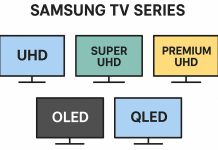Local Dimming is a technology designed to enhance the visual performance of your TV by dividing its backlight into independently controlled zones. These zones can be dimmed or switched off entirely, enabling the display to achieve deeper, more accurate blacks. This feature addresses a common issue in LCD and LED TVs—light leakage around the edges of pixels—which often causes blacks to appear gray instead of truly black. This problem stems from the limitations of VA, TN, and IPS panels. Samsung first introduced this technology under the name Micro Dimming in the early 2010s, later rebranding it as UHD Dimming with the widespread adoption of UHD displays.
While Local Dimming is often heavily marketed, its effectiveness can vary significantly depending on the type of TV backlighting. In TVs with edge lighting, the technology is essentially non-functional, as the backlight consists of only two horizontal strips, making precise control or dimming nearly impossible. In TVs with direct backlighting, some adjustments are possible, but they remain limited because a single LED often illuminates a substantial portion of the screen. Mini LED displays, however, stand out as the only LED-based screens capable of delivering satisfactory backlight control, thanks to their much finer LED zoning.
Micro Dimming Technology Overview
The naming of Micro Dimming technologies often reflects the TV’s product line rather than its actual performance, serving more as a marketing tool than a technical distinction. Here’s a breakdown of the variants:
Micro Dimming – Found in entry-level TVs, typically with EDGE backlighting. This version offers minimal control over backlight zones due to the limited hardware configuration.
Micro Dimming Pro – Used in premium TVs with direct backlighting. While marketed as an upgrade, it provides only slight improvements in backlight control compared to the basic version. The “Pro” label is primarily for branding and does not signify significant advancements.
Micro Dimming Ultimate – Incorporates more advanced backlight control with 600 or more dimming zones, enabling finer adjustments and better picture quality. However, the concept of zones has become outdated and is no longer detailed in modern TV specifications. Ultimate versions typically require more powerful processors to manage the additional zones effectively, which can enhance overall image fidelity.
In practice, the visual differences between these versions are often subtle, particularly between Pro and Ultimate, but all offer a noticeable improvement over standard backlighting.






